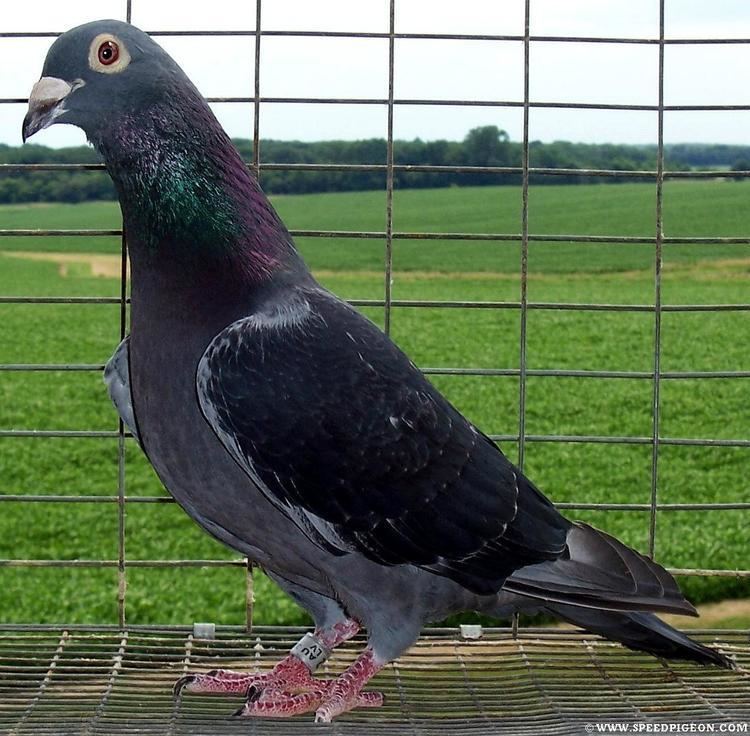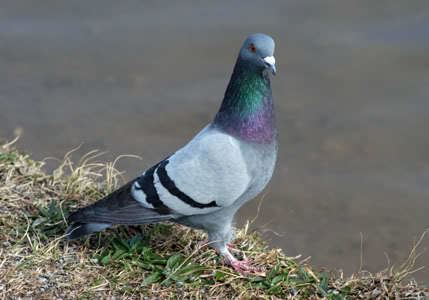Scientific name Columba livia domestica Rank Breed | Higher classification Domestic pigeon | |
 | ||
Similar Pigeons and doves, Columba, Bird, Domestic pigeon, Racing Homer | ||
The homing pigeon is a variety of domestic pigeon (Columba livia domestica) derived from the rock pigeon, selectively bred for its ability to find its way home over extremely long distances. The wild rock pigeon has an innate homing ability, meaning that it will generally return to its nest, using magnetoreception. This made it relatively easy to breed from the birds that repeatedly found their way home over long distances. Flights as long as 1,800 km (1,100 miles) have been recorded by birds in competitive pigeon racing. Their average flying speed over moderate 400 mile distances is around 80 km/h (50 miles per hour) but speeds of up to 140 km/h (90 miles per hour) have been observed in top racers for short distances.
Contents
Because of this skill, homing pigeons were used to carry messages as messenger pigeons. They are usually referred to as "pigeon post" or "war pigeon" during wars.

Homing pigeons are often incorrectly categorized as carrier pigeons, a breed of fancy pigeons selectively-bred for its distinctively rounded hard wattle.

Sexual dimorphism

Male and female pigeons (cocks and hens, respectively) can be differentiated by physical characteristics of the head, beak, height, and breast, though visual identification of sex by physical characteristics alone can be inaccurate. Males usually stand taller, and have larger beaks, crops, wattles, and eye ceres (fleshy growth around the eyes), as well as round heads and thicker napes. Females, on the other hand, tend to be shorter with smaller beaks, wattles, and ceres, as well as flatter heads and fuller breasts.
Male and female pigeons show different behaviours. The "coo" of males is louder and more insistent, especially when courting. Display behaviour also differs between the sexes. Most notably, a male often turns 360 degrees with an inflated crop and a loud "coo", to show interest in a female or to defend or discourage another pigeon from entering its territory (usually a nesting box), while females almost never turn full circle, but rather do a 270-degree back-and-forth rotational motion.
Reproduction
During breeding season, usually during the warmer months, a male pigeon will court the female by puffing out his chest, bobbing his head and strutting in circles around her, all the while cooing his affections. If she accepts, she will allow him onto her back in order to copulate. After mating, the male will build a nest out of gathered sticks in a suitable crevice, while the female watches and makes changes. Urban birds will gladly use a roof on a building. The female will usually lay two eggs which will hatch in 17 to 20 days. Both parents aid in rearing the nestlings. Fledglings usually leave the nest three to four weeks after hatching.
History
The sport of flying homing pigeons was well-established as early as 3000 years ago. They were used to proclaim the winner of the Olympics. Messenger pigeons were used as early as 1150 in Baghdad and also later by Genghis Khan. By 1167 a regular service between Baghdad and Syria had been established by Sultan Nour-Eddin. In Damietta, by the mouth of the Nile, the Spanish traveller Pedro Tafur saw carrier pigeons for the first time, in 1436, though he imagined that the birds made round trips, out and back. The Republic of Genoa equipped their system of watch towers in the Mediterranean Sea with pigeon posts. Tipu Sultan used carrier pigeons. They returned to the Jamia Masjid mosque in Srirangapatna, which was his headquarters. The pigeon holes may be seen in the mosque's minarets to this day.
In 1818, a great pigeon race called the Cannonball Run took place at Brussels. In 1860, Paul Reuter, who later founded Reuters press agency, used a fleet of over 45 pigeons to deliver news and stock prices between Brussels and Aachen, the terminus of early telegraph lines. The outcome of the Battle of Waterloo was also first delivered by a pigeon to England. During the Franco-Prussian War pigeons were used to carry mail between besieged Paris and the French unoccupied territory. In December 1870, it took ten hours for a pigeon carrying microfilms to fly from Perpignan to Bruxelles.
Historically, pigeons carried messages only one way, to their home. They had to be transported manually before another flight. However, by placing their food at one location and their home at another location, pigeons have been trained to fly back and forth up to twice a day reliably, covering round-trip flights up to 160 km (100 mi). Their reliability has lent itself to occasional use on mail routes, such as the Great Barrier Pigeongram Service established between the Auckland, New Zealand, suburb of Newton and Great Barrier Island in November 1897, possibly the first regular air mail service in the world. The world's first 'airmail' stamps were issued for the Great Barrier Pigeon-Gram Service from 1898 to 1908.
Homing pigeons were still employed in the 21st century by certain remote police departments in Odisha state in eastern India to provide emergency communication services following natural disasters. In March 2002, it was announced that India's Police Pigeon Service messenger system in Odisha was to be retired, due to the expanded use of the Internet. The Taliban banned the keeping or use of homing pigeons in Afghanistan.
To this day, pigeons are entered into competitions, with the winner receiving prize money at the end.
Navigation
Research has been performed with the intention of discovering how pigeons, after being transported, can find their way back from distant places they have never visited before. Most researchers believe that homing ability is based on a "map and compass" model, with the compass feature allowing birds to orient and the map feature allowing birds to determine their location relative to a goal site (home loft). While the compass mechanism appears to rely on the sun, the map mechanism has been highly debated. Some researchers believe that the map mechanism relies on the ability of birds to detect the Earth's magnetic field. Birds can detect a magnetic field, to help them find their way home. Scientists have found that on top of a pigeon's beak large number of particles of iron are found which remain aligned to north like a man-made compass, thus it acts as compass which helps pigeon in determining its home. A light-mediated mechanism that involves the eyes and is lateralized has been examined somewhat, but developments have implicated the trigeminal nerve in magnetoception. Research by Floriano Papi (Italy, early 1970s) and more recent work, largely by Hans Wallraff, suggest that pigeons also orient themselves using the spatial distribution of atmospheric odors, known as olfactory navigation. Near their home lofts, in areas they have previously visited, pigeons probably are guided by visual landmarks.
Research by Jon Hagstrum of the US Geological Survey suggests that homing pigeons use low-frequency infrasound to navigate. Sound waves as low 0.1 Hz have been observed to disrupt or redirect pigeon navigation. The pigeon ear, being far too small to interpret such a long wave, directs pigeons to fly in a circle when first taking air, in order to mentally map such long infrasound waves.
Various experiments suggest that different breeds of homing pigeons rely on different cues to different extents. Charles Walcott at Cornell University was able to demonstrate that while pigeons from one loft were confused by a magnetic anomaly in the Earth it had no effect on birds from another loft 1.6 km (1 mile) away. Other experiments have shown that altering the perceived time of day with artificial lighting or using air conditioning to eliminate odors in the pigeons' home roost affected the pigeons' ability to return home.
Some research also indicates that homing pigeons navigate by following roads and other man-made features, making 90-degree turns and following habitual routes, much the same way that humans navigate.
As postal carriers
When used as carrier pigeons in pigeon post a message is written on thin light paper and rolled into a small tube attached to the bird's leg. Pigeons can only go back to one "mentally marked" point that they have identified as their home, so "pigeon mail" can only work when the sender is actually holding the receiver's pigeons. White homing pigeons are used in release dove ceremonies at weddings, funerals, and some sporting events.
With training, pigeons can carry up to 75 g (2.5 oz) on their backs. The German apothecary Julius Neubronner used carrier pigeons to deliver urgent medication. In 1977 a similar carrier pigeon service was set up for the transport of laboratory specimens between two English hospitals. Every morning a basket with pigeons was taken from Plymouth General Hospital to Devonport Hospital. The birds then delivered unbreakable vials back to Plymouth as needed. The 30 carrier pigeons became unnecessary in 1983 because of the closure of one of the hospitals. In the 1980s a similar system existed between two French hospitals located in Granville and Avranche.
During war
Birds were used extensively during World War I. One homing pigeon, Cher Ami, was awarded the French Croix de guerre for her heroic service in delivering 12 important messages, despite having been very badly injured.
During World War II, the Irish Paddy, the American G.I. Joe and the English Mary of Exeter all received the Dickin Medal. They were among 32 pigeons to receive this award, for their gallantry and bravery in saving human lives with their actions. Eighty-two homing pigeons were dropped into the Netherlands with the First Airborne Division Signals as part of Operation Market Garden in World War II. The pigeons' loft was located in London, which would have required them to fly 390 km (240 miles) to deliver their messages. Also in World War II, hundreds of homing pigeons with the Confidential Pigeon Service were airdropped into northwest Europe to serve as intelligence vectors for local resistance agents. Birds played a vital part in the Invasion of Normandy as radios could not be used for fear of vital information being intercepted by the enemy.
In computing
The humorous IP over Avian Carriers (RFC 1149) is an Internet protocol for the transmission of messages via homing pigeon. Originally intended as an April Fools' Day RFC entry, this protocol was implemented and used, once, to transmit a message in Bergen, Norway, on April 28, 2001.
In September 2009, a South African IT company based in Durban pitted an 11-month-old bird armed with a data packed 4 GB memory stick against the ADSL service from the country's biggest internet service provider, Telkom. The pigeon, Winston, took an hour and eight minutes to carry the data 80 km (50 miles). In all, the data transfer took two hours, six minutes, and fifty-seven seconds—the same amount of time it took to transfer 4% of the data over the ADSL.
